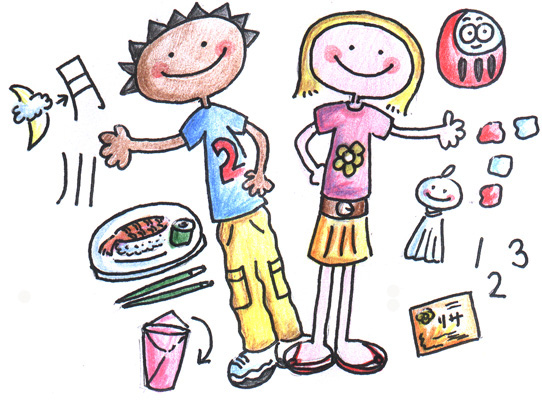Lesson 6
Lesson Plan Download pdf
Main (20 minutes)
Explain that in the following activity, the children are to be involved in the storytelling by using onomatopoeia at various points. What does onomatopoeia mean? Who can give an example? What noise does a dog make? Then explain the sounds that dogs, monkeys and pheasants make in Japanese (these are the 3 animals in the following story). Ask the Japanese teacher to demonstrate the noises/ use the kobutanukitsuneko presentation and children hazard a guess as to what animal the noises represent.
| dog | inu | 犬 | wan wan | ワンワン |
| pheasant | kiji | きじ | ken ken | ケンケン |
| monkey | saru | さる | kya kya | キャーキャー |
Ask the children if they know of any Japanese myths. Explain that today they will be looking at Momotaro, ‘The Peach Boy’. Before reading, you may wish to refresh the features of a myth (a main character with magical properties, a problem to solve, a journey, help from mythical creatures and/ or tools, a fight of good against evil, treasure, conclusion).
Read the story of Momotaro to the children, stopping at various points to ask questions and check understanding (there is a version of the story included in this lesson plan).
The Japan Society has a digital kamishibai of the Momotaro story available to download or print. A video of the kamishibai being performed is also available: https://www.japansociety.org.uk/resource?resource=16
Children should also be taught other set phrases in Japanese to call out during the story, such as ‘ganbare’ - がんばれ! (taught in Lesson 5).
Extension Ideas:
Teach children the Momotaro song in Japanese (see music score accompanying
this lesson). The children can sing the animal part, you could call out the
Momotaro reply.
If possible, perhaps try to bring in some dango riceballs for the children to
see. You can find simple recipes at the following websites:
https://www.japancentre.com/en/recipes/693-three-colour-dango-dumplings
https://www.thespruceeats.com/mitarashi-kushi-dango-2031131
Can pupils draw any parallels between Momotaro and other traditional tales they may be familiar with (such as Thumbelina/ Tom Thumb)?
Hot seating activity: Either the teacher or a pupil sits at the front of the class and takes on the role of Momotaro (they could be given a prop to hold, such as a plastic sword, which indicates they are acting in role. They could even make the prop themselves). Other pupils in the class then interview Momotaro. They should ask him questions about his journey to Oni Island and find out about his thoughts and feelings at that time.
If there is time, perhaps another child could take on the role of a different character from the story and also be interviewed (such as Momotaro’s parents, the monkey or an ogre...)

At a later stage, children could use the notes made during the interview to write up a newspaper
Children could draw a picture board version of Momotaro. Have them summarise the story into 8 points and then draw a picture to illustrate each point. Emphasise the importance of sticking to chronological order. You may also wish them to use thought and speech bubbles as in a comic strip style. Explain that picture boards were a traditional method of storytelling in Japan (called kamishibai). Why do pupils think pictures may have been more popular than a written book? (not much entertainment for children as no TVs etc and also not many books in circulation).
(Kamishibai was actually a form of street theatre. Storytellers would travel from village to village, often by bicycle. They would then set up their minitheatre and call for their audience (mainly children) using an instrument. The picture cards would then be slotted into the theatre and revealed at the appropriate time. Often, the whole story would not be told in one sitting and the storyteller would stop at the most exciting part, leaving children anxious to hear the next instalment!)
